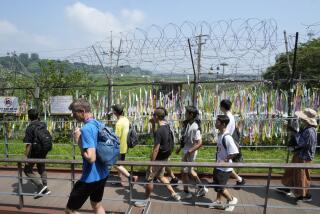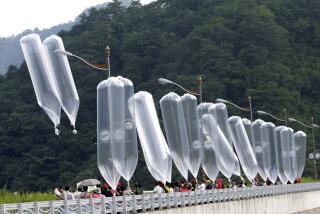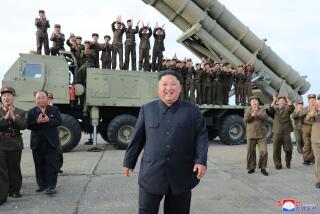S. Korea Seizes Another Northern Sub Off Coast
TOKYO â In the second such incident in less than two years, South Korea on Monday captured off its coast a North Korean submarine--the type of vessel often deployed in spy missions, though the intentions and fate of the crew of this mission were not immediately known.
The seizure comes at a time when new South Korean President Kim Dae Jung has been taking a markedly softer line toward the hostile, Communist North than his predecessors.
Presidential spokesman Park Jie Won had no comment on whether the incident would scuttle Kimâs âsunshine policyâ of seeking engagement, exchanges and rapprochement between the two Koreas, but Western analysts said it need not force Kim into a harder-line approach.
The sub, a Yugo-class miniature capable of carrying seven to 10 people, apparently became ensnared in a fishing net about 11 1/2 miles off the coast of Sokcho in the Sea of Japan, not far from the demilitarized zone, or DMZ, but inside South Korean territorial waters, South Korean authorities said.
The crew members of the fishing boat spotted the sub at 4:30 p.m. Monday, lying partially submerged, and said they saw two or three people moving on its deck, trying to extricate it from the fishing net. The North Koreans waved at the fishermen, apparently as if to assure them that the sub was South Korean, Kim In Yong, the captain of the fishing boat, told local television.
The sub was freed and began to sail north, but the fishing boat followed and reported the incident to authorities. Before the South Korean navy arrived, the sub had turned belly-up in the sea, the captain said.
When South Korean helicopters and naval ships arrived, they fired an explosive into the water and demanded that the subâs crew surrender but received no response. By about 7:30 p.m., South Korean authorities had seized the vessel and bound it with rope to tow it to shore.
Authorities decided it was too dangerous to attempt to open the tightly sealed hatches by force and were towing the sub toward a naval base this morning. The vessel was expected to arrive in port this afternoon.
âIt was confirmed that the submarine was North Korean, and we believe it is a clear violation of the armistice agreement,â said Col. Park In Yong, a spokesman for the Korean joint chiefs of staff.
A spokesman for Kim Dae Jung said the president had issued orders for the military to âreact calmlyâ and would make a judgment after a previously scheduled meeting--to be held later today in the DMZ--between military officials of North Korea and the United Nations command, which administers the 1953 armistice agreement that ended the Korean War.
The incident came as relations between the two nations seemed to be thawing. Last week, for the first time, Chung Ju Young, founder of South Koreaâs Hyundai Group, drove 500 head of cattle across the DMZ to his native village in North Korea as a goodwill gift. Chung returned home from the North through the DMZ today, saying he had agreed with North Korean officials to develop a mountain in North Korea for South Korean tourism.
âAs early as this autumn, we may be able to send 1,000 tourists a day by passenger boat to sightsee on Kumkang Mountain,â Chung said. The mountain is in southeastern North Korea, an easy sail from the south.
South Koreans interviewed on television said they hoped the sub incident would not slow the North-South thaw. âWe send cows, and they send us back a submarine,â complained a young South Korean man interviewed by KBS state television.
*
North-South relations took a precipitous dive after the last North Korean sub ran aground on a reef off Kangnung, also in northeastern South Korea, in September 1996, with a crew of 25 aboard. The crew escaped, triggering a nationwide manhunt that ended with the deaths of several South Korean soldiers and civilians, and a mass suicide of 11 of the North Korean infiltrators. All but one of the 25 North Koreans perished.
Lee Kwang Soo, the only surviving North Korean from that mission, remains in South Korean custody, and authorities were reportedly dispatching him to help negotiate with the crew captured today--if its members are still alive.
Captured North Korean agents and defectors have said that standing orders required agents to commit suicide to avoid capture, and the South Korean defense ministry said the crew was presumed dead--either by suffocation or suicide--since there was no sign of life aboard and no survivors found in the water. A special team was being assembled in port to open the sub.
âThere is nothing surprising about this incident, except perhaps the ineptitude of the North Korean captain,â said Nicholas Eberstadt, a North Korea expert at the American Enterprise Institute in Washington, noting that North Korea has not renounced its official view that Korean reunification can come only through collapse of the South or an invasion by the North.
âIf it turned out the new administration was completely unprepared for such an eventuality, that would be a worrisome naivete, but by itself this should not wreck the sunshine policy,â Eberstadt said. Kim repeatedly has said he has âno illusionsâ about the North Korean regime. âIf he has no illusions about North Korea, then he will have expected this,â Eberstadt said.
In fact, South Korean authorities appeared to be taking a much more tolerant approach to the latest sub incident. âThe authorities are of the opinion that this submarine was not meant for infiltration,â defense ministry spokesman Park In Yong said. First, Park said, a mother boat usually lurks in the area to oversee spy operations, but no such North Korean vessel was spotted this time. Second, the Yugo, a smaller vessel than its predecessor, is lightly armed, carrying only machine guns.
âThe possibility is it may have become stranded during normal training, or come to pick up some agents, or it may have been returning to the north from exercises when it was caught on the net,â Park said.
However, Park Suk Kyun, a North Korea expert at the Freedom League in Seoul, called the government suggestion that the sub was not on a spy mission âa sheer lie.â
âThat submarine can sail only 140 km [87 miles] without the help of a mother vessel,â Park said. âThere was a mother vessel. Authorities failed to locate it, thatâs all.â
Park suggested that the North intends to test the limits of Kimâs sunshine policy--and that the Northern regime requires the continued presence of a South Korean enemy in order to control its population during the current hunger and economic hardship.
âIf Kim continues with economic aid and cooperation regardless of this incident, then Pyongyang will assume a freedom of military action,â he warned.
But Joel Wit, a North Korea expert at the Henry L. Stimson Center in Washington, said this incident is not likely to have the same impact as the last sub incursion because the antipathy between the North and former South Korean President Kim Young Sam has given way to a broad spectrum of nongovernmental contacts between the two Koreas, and because this sub appears to pose less of a threat.
âThereâs a big difference between having a bunch of North Koreans roaming the countryside shooting people and a bunch of guys who have sealed themselves in a sub,â Wit said. He predicted that âthe South Koreans are going to want to put this behind them very quickly. South Koreans have a lot of other problems with the Asian economic crisis, and they donât need another blowupâ in North-South relations.
*
In Washington, State Department spokesman James P. Rubin said, in an apparent reference to President Clintonâs upcoming controversial trip to China, that the Korean incident was âa reminder of why it is so important to engage with China in discussions on matters of regional security,â Reuters news service reported.
The tense Korean peninsula âis a dangerous place, and when there are risks to American interests we do believe that talking to the Chinese and promoting maximum cooperation by them is good for American national interests,â Rubin said.
Although China is no longer North Koreaâs unquestioning patron, it has closer ties to the isolated Stalinist regime than any other nation--though some Western analysts have doubts about how much influence even Beijing can wield over the intensely nationalistic leadership in Pyongyang.
*
Chi Jung Nam of The Timesâ Seoul Bureau contributed to this report.
More to Read
Sign up for Essential California
The most important California stories and recommendations in your inbox every morning.
You may occasionally receive promotional content from the Los Angeles Times.










